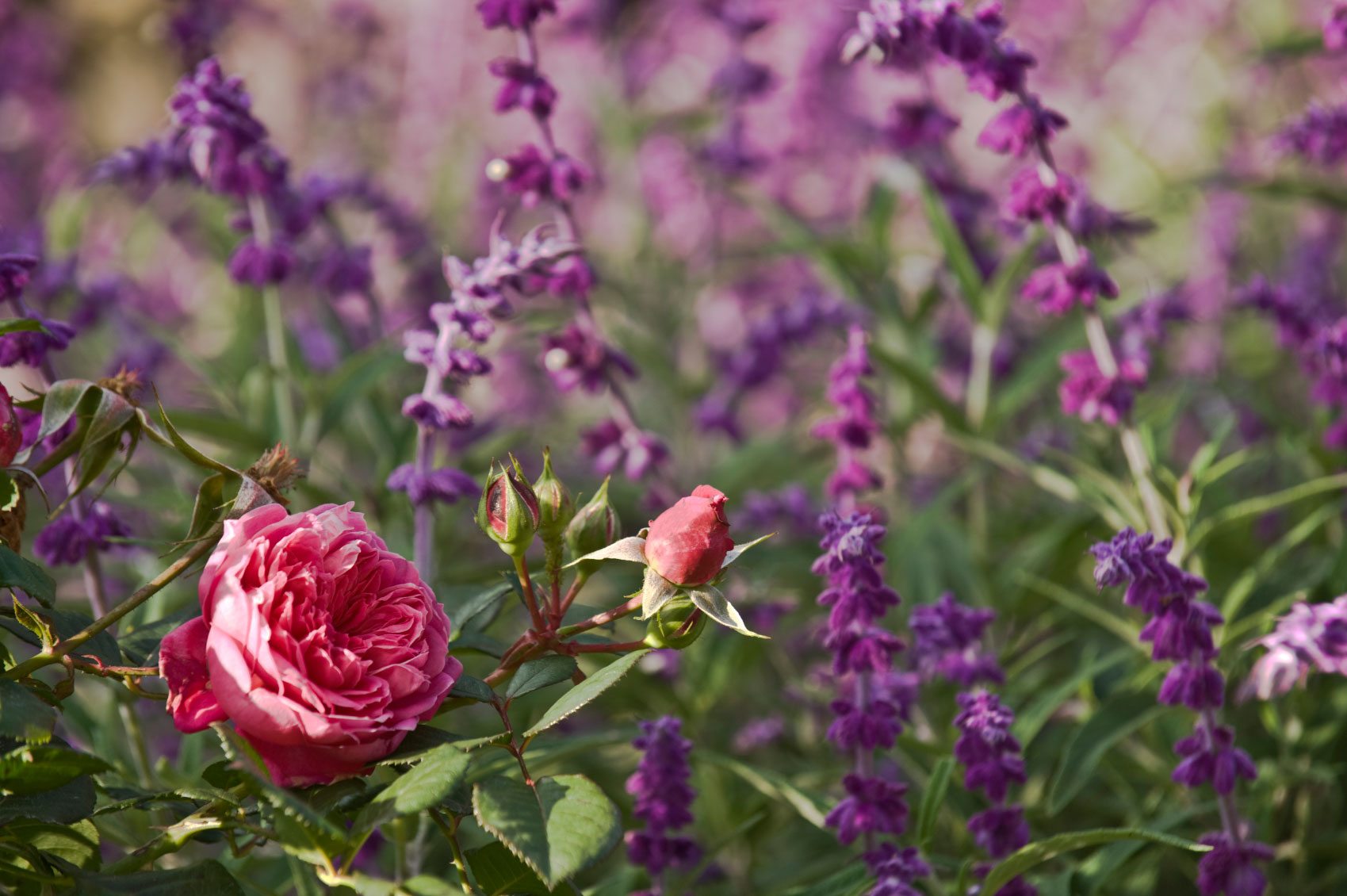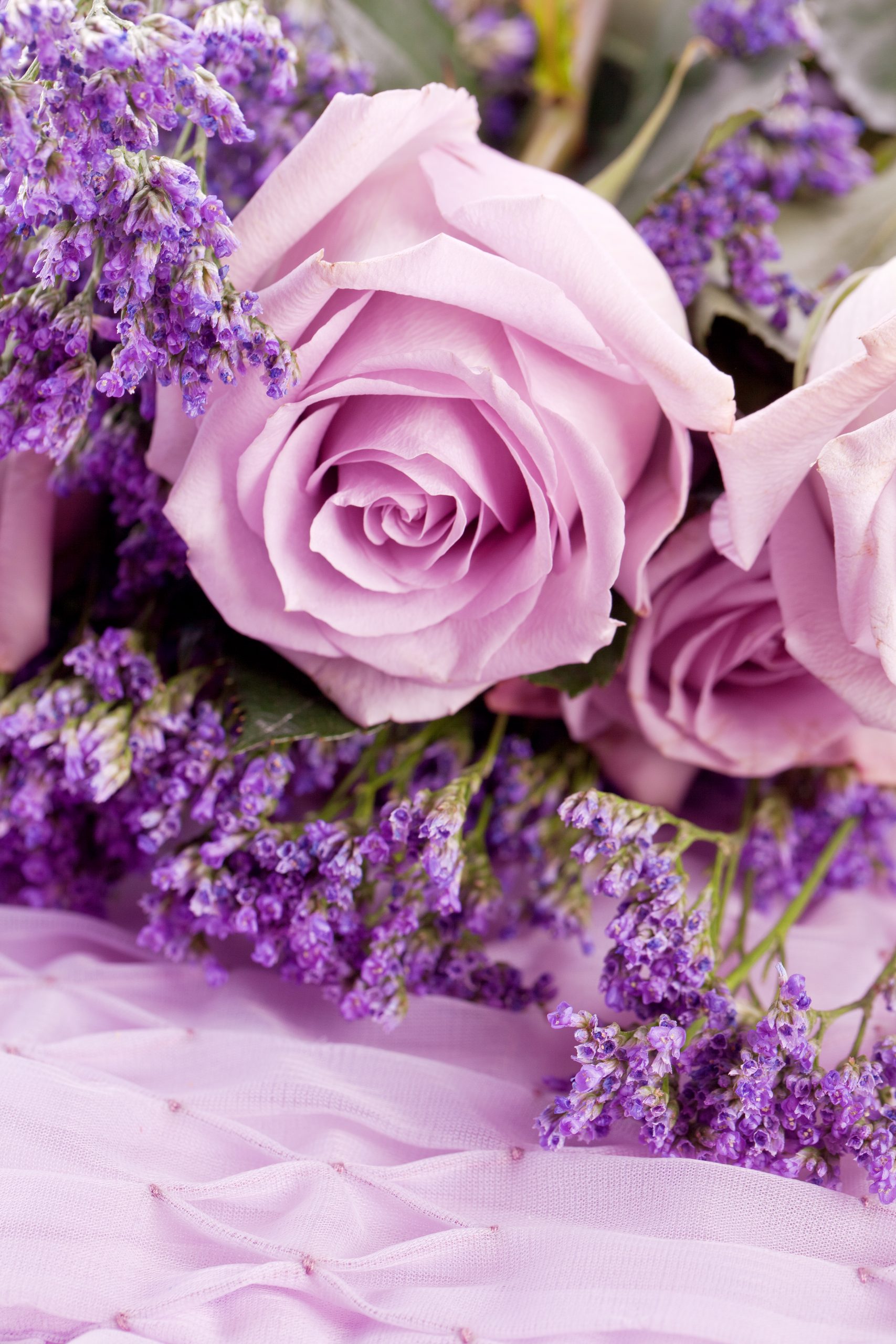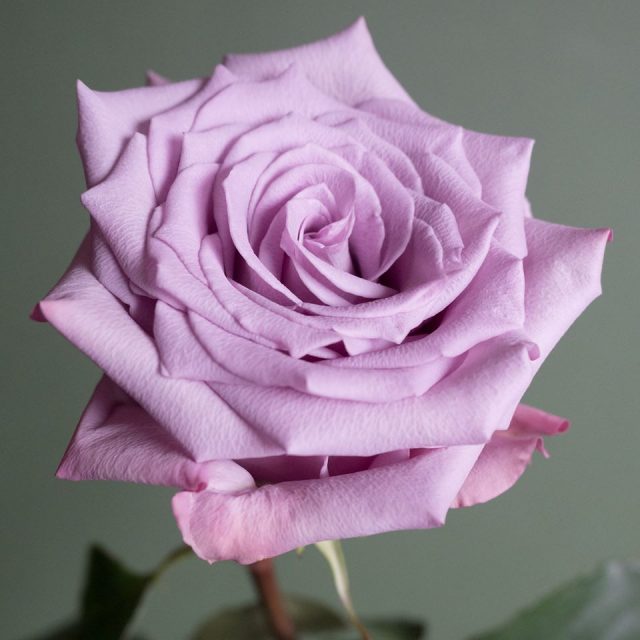
Roses and lavender may coexist peacefully since they both flower at roughly the same time and have similar growing requirements, such as full light and soil that drains well. Roses and lavenders should be planted 2-3 feet apart since lavenders demand drier soil, less water, and poorer soil richness than roses.
Lavender and rose plants can generate their best bloom and scent when they are spaced apart, allowing you to cater to their own tastes.
Here are five suggestions for planting lavender alongside roses.
- Planting roses and lavender 2-3 feet apart (therefore plants do not have to compete for airflow, light, water, nutrients etc.)
- localize the rose and lavender soil conditions (lavenders need more drainage then roses)
- Don’t feed lavender; only roses (lavenders prefer low to medium fertility soil conditions)
- More often than lavender, water roses (Water roses once per week, lavenders once every two weeks)
- Roses can use organic mulch, but not lavender (Conserves moisture and adds fertility to roses, lavenders prefer dryer soil).
When in bloom, lavender and roses look stunning together. Continue reading to learn how to ensure that both plants grow to their best potential despite the disparities in their growing environments.
Table of Contents
Plant Lavender 3 Feet Apart from Roses
When given ample room in the garden, roses and lavenders will flourish and produce the greatest blossoms. Planting lavender and roses in a space of 2-3 feet will yield the finest results.
Each plant will have enough room as a result to:
- The most illumination (both lavenders and roses need full sun)
- enough access to nutrients to cause competition between each root system. (Roses dislike competition and are big feeders.)
- Both roses and lavender benefit from having room for air to pass through the foliage since it lowers the likelihood that either plant may contract a fungus.
- Deadheading and annual pruning are beneficial for both roses and lavender. Since there is distance between the plants, you, the gardener, will be able to tend to each one without getting injured by the rose thorns! (Whenever handling flowers, put on gauntlet gloves for safety.)
- You can further customize the soil conditions for each plant (wet dirt for roses and dry soil for lavenders) by giving them a gap of 2 to 3 feet apart, and you can water the rose without watering the lavenders to keep both plants healthy.
In order to avoid shading each other during a hot day, which can stunt growth, flowering, and scent, both lavenders and roses require this much distance.
For advice on how often to water lavender and how to water roses, read my articles.
soil pH
The preferred soil pH for roses and lavender has some overlap. Roses can grow in soils with a pH of 6-7, whereas lavender may thrive in soils with a pH of 6.5-8.
It is a good idea to conduct a soil test before purchasing or planting lavender because if your soil has a pH below 6.5 (acidic), it will not be suited for growing lavenders of any type. See my article on lavenders and acidic soil for further details on how to achieve this.
In mildly acidic soils with a pH of around 6.5, the English lavender species tends to grow slightly better than French lavenders, whilst French lavender may start to exhibit signs of stress, such as poor growth, so it is preferable to choose English lavenders for Rose planting. (Learn more about the distinctions between French and English lavenders.)
Most garden soil has a pH of 6-7 because this is the pH of most organic matter once it has fully decomposed. However, it is always advisable to test your soil first because soil gauges are inexpensive on Amazon and cost a fraction of the price of roses and lavender plants, which may not survive if the soil is unsuitable.
Localise Soil Conditions for Roses and Lavenders

Both roses and lavender appreciate well-draining soil. The distinction is that roses prefer soil with a high organic content for growth. While being porous enough to let excess water drain away from the roots, soils rich in organic matter (compost) also absorb and hold onto moisture close to the roots.
As a result, the roses will benefit since they prefer their roots to be able to absorb moisture from the soil when they need it without the soil becoming saturated.
On the other hand, lavenders require significantly drier soil. Lavenders thrive in sandy, well-draining soil in their native Mediterranean zone and are more prone to succumb to root rot in rich soil.
The secret to successfully pairing lavender with roses is to modify the soil for each plant:
- Create a hole that is 18 inches in both width and depth before planting the lavenders. Fill the hole with coarse sand or gravel such that compost makes up the remaining two thirds of the soil mixture and about a third of the soil mix is sand.
Sand does not hold onto moisture in the same way that compost does, so there will be less material keeping moisture around the roots, preventing the lavender from getting root rot. This will also help the drainage of the soil.
The low to medium fertility conditions that lavenders require to flower and release a potent aroma will also be helped by the sand.
(Read my article on the ideal soil mix for lavenders for more details.)
On the other hand, roses prefer to be planted in soil that has been heavily amended with rich organic material, such as leaf mould, compost, and well-rotted manure, as this will help to retain water and provide an abundance of nutrients in the soil, ensuring they stay healthy and produce their best flowers.
Avoid Feeding Lavenders when Feeding roses
In terms of recommended soil fertility, roses and lavender differ significantly from one another. The reason why lavenders don’t need feeding is explained in my post. On contrast, roses grow best and produce the most blossoms in high fertility soils and benefit from additional fertilizer.
Lavenders are well adapted to growing in sandy soils with poor nutrition, therefore feeding them will promote leaf growth at the price of flowers.
- The best aroma and flowering of lavenders occur in low- to medium-fertility soil conditions.
- Roses bloom at their finest in healthy soil and after receiving a springtime feeding.
This underlines how crucial it is to leave some space between lavender and rose plants in the same flower bed so you can pinpoint the ideal soil conditions for each plant.
The sand or gravel you added to the soil before planting the lavenders will aid in balancing the soil’s fertility because sand doesn’t offer many nutrients, which is ideal for producing lavender.
You can space your plants 3 feet apart so that you can fertilize your roses in the spring without affecting the soil where your lavender plants grow.
Instead of using liquid fertilizers, I would personally advise using granular feeds like Miracle Grow Continuous Release Rose and Shrub Plant Food because you can control where the feed is applied and there is much less risk of raising the soil fertility of the entire flower bed, which will decrease the likelihood of lavenders flowering.
You will experience a beautiful multi-species bloom because both roses and lavender bloom in the spring and summer.
Water Roses more Frequently then Lavenders
The amount of water that lavender and roses prefer to have is one of their main distinctions.
- Lavender is a drought-tolerant plant that does well in hot, sunny weather with little water. If there hasn’t been any rain, established lavender plants only need to be watered once every two weeks during the growing season.
- Although flowers need a lot more water, roses may grow in hot, sunny conditions. During the growing season, roses need a good bath once a week. During exceptionally hot times, they will need watering every three days.
This variation in preferred watering methods emphasizes the significance of planting your roses and lavenders at the proper spacing.
Each plant benefits from a good soak each time as this helps roots to establish in the soil. Always aim the water directly at the base of each plant (so that you don’t wind up overwatering the lavender).
It’s crucial to attend to each plant’s needs since with lavender, overwatering is almost usually a bigger issue than underwatering.
Read my article on how frequently to water lavender for more information. It has all the best practices you need to maintain your lavender healthy and free of fungus.
Add Mulch to Roses not Lavenders

Mulch is beneficial for roses in the spring because:
- Mulch aids in moisture preservation for the upcoming summer.
- Mulch will promote flowering and increase the roses’ resistance to disease by bringing fertility to the soil.
Apply the mulch and a 1-inch layer of mulch to the soil surrounding the rose (rotted manure, leaf mold, and garden compost are all suitable options).
Since the wood above ground dislikes touch with consistently damp materials, leave a 6 inch ring of dirt between the mulch and the rose stem.
Contrarily, lavenders prefer dry soil, so be careful to keep the mulch confined to the area surrounding the roses. Keep the ground free of mulch and other organic debris that has fallen to the ground because moisture-retentive mulch will only encourage the circumstances that make lavenders more susceptible to fungal disease (such as leafs in the Fall).
Key Takeaways:
- While they can be grown together and appear stunning when in bloom at the same time, lavender and roses have different growing requirements. Both plants will thrive if certain changes and care are made.
- Planting lavenders and roses separately will allow you to account for the fact that lavenders prefer dry soil (amend with sand for quick drainage) and roses prefer soil that retains some moisture and contains more organic matter. The key is to plant lavenders and roses separately by a distance of 2-3 feet.
- Do not regularly water roses and lavender together because they demand different amounts of water. If there hasn’t been any rain, lavenders only need to be watered once every two weeks. In extreme heat, water roses once every three days in addition to once a week.
- You can feed the roses without feeding the lavenders if you plant them 2-3 feet apart. Roses require high soil fertility, but lavender prefers low to medium fertility.
- – Roses. Lavender and roses are a classic, pretty pairing. … Since you can control where the feed is applied and there is much less risk of raising the soil fertility of the entire flower bed, which will decrease the likelihood of lavenders flowering, I would personally advise using granular feed instead of liquid fertilizers. A good example is Miracle Grow Continuous Release Rose and Shrub Plant Food.
